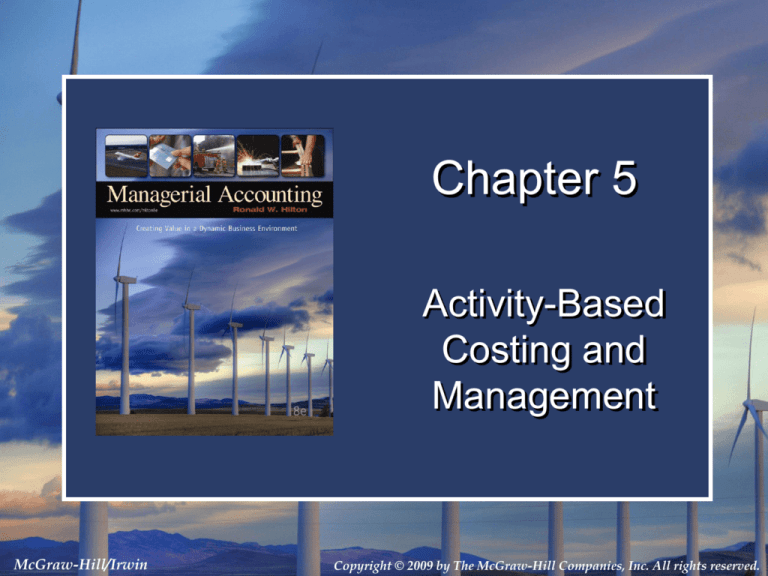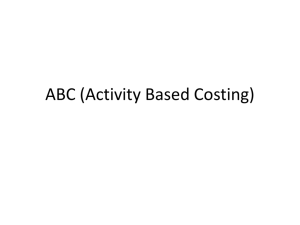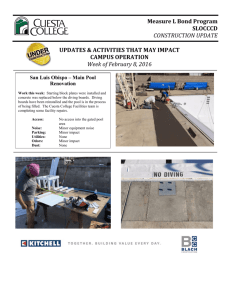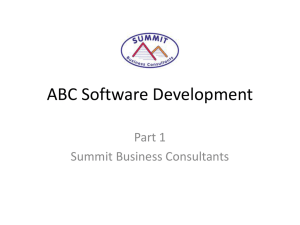
Chapter 5
Activity-Based
Costing and
Management
McGraw-Hill/Irwin
Copyright © 2009 by The McGraw-Hill Companies, Inc. All rights reserved.
Learning
Objective
1
McGraw-Hill/Irwin
Copyright © 2009 by The McGraw-Hill Companies, Inc. All rights reserved.
Traditional, Volume-Based
Product-Costing System
• Aerotech produces three complex printed circuit
boards referred to as Mode I, Mode II, and Mode
III.
• The following information is obtained from
company records:
Production:
Units
Runs
Mode I
Mode II
Mode III
10,000
1 run of 10,000
units
20,000
4 runs of
5,000 units
4,000
10 runs of
400 units
5-3
Traditional, Volume-Based
Product-Costing System
Direct materials
Direct labor
Manufacturing overhead
Total
$
$
Mode I
50.00
60.00
99.00
209.00
Mode II
$
90.00
80.00
132.00
$
302.00
Mode III
$
20.00
40.00
66.00
$
126.00
Additional information includes:
Direct materials
Direct labor (hr/board)
Setup time (hr/run)
Machine time (hr/board)
$
Mode I
50.00
3
10
1
Mode II
$
90.00
4
10
1.25
Mode III
$
20.00
2
10
2
Manufacturing overhead is determined as follows
5-4
Traditional, Volume-Based
Product-Costing System
Mode I
10,000
3
30,000
Units produced
Direct labor (hr/unit)
Total hours
Mode II
20,000
4
80,000
Total hours required
118,000
Budgeted manufacturing overhead
Budgeted direct-labor hours
$3,894,000
118,000
Mode I
Direct labor (hr/unit)
Overhead rate per hour
Overhead per unit
Mode III
4,000
2
8,000
$
$
= $33 per hour
Mode II
3
33
99
$
$
Mode III
4
33
132
$
$
2
33
66
5-5
Traditional, Volume-Based
Product-Costing System
With these product costs, Aerotech established
target selling prices (Cost × 125%).
Direct materials
Direct labor
Manufacturing overhead
Total
Cost per unit
Target selling price
$
$
$
Mode I
Mode II
Mode III
50.00 $
90.00 $
20.00
60.00
80.00
40.00
99.00
132.00
66.00
209.00 $
302.00 $
126.00
Mode I
209.00
261.25
Mode II
$
302.00
377.50
Mode III
$
126.00
157.50
209.00 x 1.25
5-6
Learning
Objective
2
McGraw-Hill/Irwin
Copyright © 2009 by The McGraw-Hill Companies, Inc. All rights reserved.
Activity Based Costing System
(ABC)
ABC systems follow a two-stage procedure
to assign overhead costs to products.
Stage One
Identify significant activities and assign overhead costs
to each activity in proportion to resources used.
Stage Two
Identify cost drivers appropriate to each activity and
allocate overhead to the products.
5-8
Learning
Objective
3
McGraw-Hill/Irwin
Copyright © 2009 by The McGraw-Hill Companies, Inc. All rights reserved.
Overhead Costs
Total budgeted cost = $3,894,000
Activity
must be
done on
each unit
produced.
Activity
Cost
Pools
Unit
Level
Batch
Level
ProductSustaining
Level
Machinery
cost pool
$1,212,600
Setup
cost pool
$3,000
Engineering
cost pool
$700,000
Activity
performed
on each
batch
produced.
Activities needed to support
an entire product line
Identification
of Activity
Cost Pools
Facility
Level
Facility
cost pool
$507,400
Activity required in order
for the production
process to occur.
5-10
Unit
Level
Batch
Level
ProductSustaining
Level
Machinery
cost pool
$1,212,600
Setup
cost pool
$3,000
Engineering
cost pool
$700,000
Facility
Level
Facility
cost pool
$507,400
Receiving/Inspection
cost pool $200,000
Material-Handling
cost pool $600,000
Quality-Assurance
cost pool $421,000
Packaging/Shipping
cost pool $250,000
5-11
Learning
Objectives
3&4
McGraw-Hill/Irwin
Copyright © 2009 by The McGraw-Hill Companies, Inc. All rights reserved.
STAGE ONE
Various overhead
costs related
to machinery
Activity
cost
pool
Maintenance
Lubrication
Depreciation
Electricity
Computer Support
Calibration
Machinery Cost Pool
Total budgeted cost = $1,212,600
5-13
STAGE TWO
Calculate
the pool
rate
Cost
Assignment
Budgeted Machinery Costs = $1,212,600
Budgeted Machine Hours
43,000
= $28.20/hour
Mode I:
$28.20 per hr.
1 hr. per unit
$28.20 per unit
Mode II:
$28.20 per hr.
1.25 hr. per unit
$35.25 per unit
Mode III:
$28.20 per hr.
2 hr. per unit
$56.40 per unit
5-14
STAGE ONE
Calculation of
total setup cost
Activity
cost
pool
Total budgeted setup cost
$20 per hour
10 hr. per setup
$200 cost per setup
15 production runs
$ 3,000 Total
Setup Cost Pool
Total budgeted cost = $3,000
5-15
STAGE TWO
Calculate
the pool
rate
Cost
Assignment
Budgeted Setup Costs
Planned Production Runs
Mode I: (1 Run)
$200 per run
10,000 units per run
= $.02 per unit
= $3,000
15 runs
= $200 per run
Mode II: (4 Runs)
$200 per run
5,000 units per run
= $.04 per unit
Mode III: (10 Runs)
$200 per run
400 units per run
= $.50 per unit
5-16
STAGE ONE
Various overhead
costs related
to engineering
Activity
cost
pool
Engineering salaries
Engineering software
Engineering supplies
Depreciation
Engineering Cost Pool
Total budgeted cost = $700,000
5-17
STAGE TWO
Allocate based
on engineering
transactions
Cost
Assignment
Engineering Cost Pool
Total budgeted cost = $700,000
Mode I:
25% × $700,000
10,000 units
= $17.50 per unit
Mode II:
45% × $700,000
20,000 units
= $15.75 per unit
Mode III:
30% × $700,000
4,000 units
= $52.50 per unit
5-18
STAGE ONE
Various overhead
costs related
to general
operations
Activity
cost
pool
Plant depr.
Property taxes
Plant mgmt.
Insurance
Plant maint.
Security
Facility Cost Pool
Total budgeted cost = $507,400
5-19
STAGE TWO
Calculate
the pool
rate
Cost
Assignment
Budgeted Facilities Cost
= $507,400
Budgeted Direct-Labor Hours
118,000
= $4.30/hour
Mode I:
$4.30 per hr.
×
3 hr. per unit
$12.90 per unit
Mode II:
$4.30 per hr.
×
4 hr. per unit
$17.20 per unit
Mode III:
$4.30 per hr.
×
2 hr. per unit
$8.60 per unit
5-20
Other Overhead Costs
Receiving and Inspection Cost Pool
Board
Overhead
Mode I
$ 200,000
Mode II
200,000
Mode III
200,000
×
×
×
×
%
6%
24%
70%
÷
÷
÷
÷
Units
10,000
20,000
4,000
= Cost/Unit
= $
1.20
=
2.40
=
35.00
Material-Handling Cost Pool
Board
Overhead
Mode I
$ 600,000
Mode II
600,000
Mode III
600,000
×
×
×
×
%
7%
30%
63%
÷
÷
÷
÷
Units
10,000
20,000
4,000
= Cost/Unit
= $
4.20
=
9.00
=
94.50
Quality-Assurance Cost Pool
Board
Overhead
Mode I
$ 421,000
Mode II
421,000
Mode III
421,000
×
×
×
×
%
20%
40%
40%
÷
÷
÷
÷
Units
10,000
20,000
4,000
= Cost/Unit
= $
8.42
=
8.42
=
42.10
Packaging and Shipping Cost Pool
Board
Overhead
Mode I
$ 250,000
Mode II
250,000
Mode III
250,000
×
×
×
×
%
4%
30%
66%
÷
÷
÷
÷
Units
10,000
20,000
4,000
= Cost/Unit
= $
1.00
=
3.75
=
41.25
5-21
Other Overhead Costs
Receiving and Inspection Cost Pool
Board
Overhead
Mode I
$ 200,000
Mode II
200,000
Mode III
200,000
×
×
×
×
%
6%
24%
70%
÷
÷
÷
÷
Units
10,000
20,000
4,000
= Cost/Unit
= $
1.20
=
2.40
=
35.00
Material-Handling Cost Pool
Board
Overhead
Mode I
$ 600,000
Mode II
600,000
Mode III
600,000
$14.82
×
×
×
×
%
7%
30%
63%
÷
÷
÷
÷
Units
10,000
20,000
4,000
= Cost/Unit
= $
4.20
=
9.00
=
94.50
Quality-Assurance Cost Pool
Board
Overhead
Mode I
$ 421,000
Mode II
421,000
Mode III
421,000
×
×
×
×
%
20%
40%
40%
÷
÷
÷
÷
Units
10,000
20,000
4,000
= Cost/Unit
= $
8.42
=
8.42
=
42.10
Packaging and Shipping Cost Pool
Board
Overhead
Mode I
$ 250,000
Mode II
250,000
Mode III
250,000
×
×
×
×
%
4%
30%
66%
÷
÷
÷
÷
Units
10,000
20,000
4,000
= Cost/Unit
= $
1.00
=
3.75
=
41.25
5-22
Product Cost from ABC
These are the new product costs when
Aerotech uses ABC.
Mode I
Direct materials $ 50.00
Direct labor
60.00
Machinery
28.20
Setup
0.02
Engineering
17.50
Facilities
12.90
Other
14.82
Total
$ 183.44
Mode II
$ 90.00
80.00
35.25
0.04
15.75
17.20
23.57
$ 261.81
Mode III
$ 20.00
40.00
56.40
0.50
52.50
8.60
212.85
$ 390.85
5-23
Learning
Objective
5
McGraw-Hill/Irwin
Copyright © 2009 by The McGraw-Hill Companies, Inc. All rights reserved.
Distorted Product Costs
Both original and ABC target selling prices are
based on (Cost × 125%).
Traditional costing
ABC costing
Original target selling price
ABC target selling price
Mode I
$
209.00
183.44
Mode II
$
302.00
261.81
Mode III
$ 126.00
390.85
261.25
229.30
377.50
327.26
157.50
488.56
The selling price of Mode I and II are reduced
and the selling price for Mode III is increased.
[$209.00 × 1.25]
[$183.44 × 1.25]
5-25
Distorted Product Costs
Can you identify any problems Aerotech is likely
to face as a result of this distortion?
Mode I
Traditional costing
$ 209.00
ABC costing
183.44
Cost distortion per unit
25.56
Units produced
10,000
Total cost distortion
255,600
Mode II
$ 302.00
261.81
40.19
20,000
803,800
Mode III
$ 126.00
390.85
(264.85)
4,000
(1,059,400)
Traditional costing understates the cost
of complex, low volume products.
5-26
Two Key Points
A large proportion of nonunit-level activities
A unit-level cost driver,
such as direct labor,
machine hours, or
throughput, will not be
able to assign the costs
of non-unit-level activities
accurately.
Product diversity
When the
consumption ratios
differ widely between
activities, no single
cost driver will
accurately assign the
resulting overhead
costs.
5-27
Learning
Objective
6
McGraw-Hill/Irwin
Copyright © 2009 by The McGraw-Hill Companies, Inc. All rights reserved.
Cost Drivers
A characteristic of an event or activity that results
in the incurrence of costs. In selecting a cost
driver, we must consider . . .
Degree of
Correlation
Behavioral
Effects
Cost of
Measurement
5-29
Learning
Objective
7
McGraw-Hill/Irwin
Copyright © 2009 by The McGraw-Hill Companies, Inc. All rights reserved.
COLLECTING ABC DATA
INTERVIEWS AND PAPER TRAILS - The information
for ABC systems initially comes from interviews with
employees in the support departments and a review of each
department’s records.
STORYBOARDING - A procedure used to develop a
detailed process flow chart, which visually represents activities
and the relationships among activities.
MULTIDISCIPLINARY ABC PROJECT TEAMS – To
gather information from all facets of an organizations
operations, it is essential to involve personnel from a variety of
functional areas. A typical ABC project team includes
ACCOUNTING, FINANCE, PRODUCTION, OPERATIONS,
ENGINEERS, MARKETING etc.
5-31
Learning
Objective
8
McGraw-Hill/Irwin
Copyright © 2009 by The McGraw-Hill Companies, Inc. All rights reserved.
Activity-Based Management
The use of
ABC costing
information
to help
management
make decisions
5-33
Activity-Based Management
Activity-based costing establishes relationships
between overhead costs and activities so that
we can better allocate overhead costs.
Activity-based management focuses
on managing activities to reduce costs.
5-34
Two-Dimensional ABC and ActivityBased Management
Activities
5-35
Two-Dimensional ABC and ActivityBased Management
Cost Assignment View
Resource costs
Activities
Cost Objects
5-36
Two-Dimensional ABC and ActivityBased Management
Cost Assignment View
Resource costs
Process View
Activity Analysis
Root
Causes
Activity
Triggers
Activity Evaluation
Activities
Performance
Measures
Cost Objects
5-37
Elimination of Non-Value-Added
Costs
Activities
Nonvalueadded
activities
Unnecessary
Necessar
y
Reduce or
Eliminate
Continually Evaluate
and Improve
5-38
Using ABM to Eliminate Non-ValueAdded Activities and Costs
1. Identify Activities.
2. Identify Non-Value-Added Activities.
3. Understand Activity Linkages, Root Causes,
and Triggers.
Specify
parts
Select
vendor
Receive
parts
Produce
goods
Inspect
finished
goods
Rework
defective
products
4. Establish Performance Measures.
5. Report Non-Value-Added Costs.
5-39
Using ABM to Eliminate Non-ValueAdded Activities and Costs
Process time
Inspection time
Move time
Storage time
Waiting time
5-40
Learning
Objective
9
McGraw-Hill/Irwin
Copyright © 2009 by The McGraw-Hill Companies, Inc. All rights reserved.
Customer Profitability Analysis
Customer profitability analysis uses
activity-based costing to determine
the activities, costs, and profit associated
with serving particular customers.
5-42
Customer Profitability Analysis
Required
special
packaging.
Orders
small
quantities.
Demand
fast
service.
Often
changes
orders.
Orders
frequently.
A costly customer
5-43
Customer Profitability Analysis
Customer-Related Activities
Order processing
Sales contacts (phone calls, faxes, etc.)
Sales visits
Shipment processing
Billing and collection
Design/engineering change orders
Special packaging
Special handling
Cost Driver Base
Purchase orders
Contacts
Visits
Shipments
Invoices
Design changes
Units packaged
Units handled
Cost Drive
Rate
$
150
100
1,000
200
160
4,000
40
60
A company may use these customer
related costs to help determine the
profitability of each customer.
5-44
Customer Profitability Analysis
Cumulative Operating Income as a % of Total
Operating Income
Customer Profitability
125.0%
100.0%
75.0%
50.0%
25.0%
75% of actual operating income
50% of actual operating income
25% of actual operating income
0.0%
1
2
3
4 5
6
7
8 9 10 11 12 13 14 15 16 17 18 19 20
5-45
Learning
Objective
10
McGraw-Hill/Irwin
Copyright © 2009 by The McGraw-Hill Companies, Inc. All rights reserved.
Activity-Based Management in the
Service Industry
Customer
Profitability
Analysis
Activity
Analysis
5-47
Learning
Objective
11
McGraw-Hill/Irwin
Copyright © 2009 by The McGraw-Hill Companies, Inc. All rights reserved.
Just-in-Time Inventory and
Production Management
No materials are purchased and no products
are manufactured until they are needed.
The primary goal of a
JIT production system is
to reduce or eliminate
inventories at every
stage of production.
5-49
Key Features of the JIT Approach
Smooth, uniform production rate
Pull method of production
Purchase is small lot sizes
Quick, inexpensive setups
High quality materials
Effective preventive maintenance
Teamwork
Multiskilled workers
5-50
JIT Purchasing
Long-term
contracts with
suppliers.
Only a few
suppliers.
Parts delivered
in small lots.
Grouped
payments to
vendor.
Minimal
inspection of
materials.
5-51
End of Chapter 5
This is
my kind of cost
pool!
5-52







